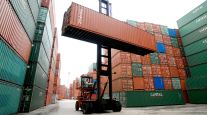Growth of Domestic Truck/Rail Shipments Expected to Highlight Intermodal Expo
This story appears in the Nov. 7 print edition of Transport Topics.
When the largest U.S. intermodal event returns to its roots in Atlanta next week, Intermodal Expo attendees will be talking about an industry in which steadily growing domestic truck/rail shipments are stealing the spotlight from slow-growing international cargo.
In addition to the Intermodal Association of North America’s Expo, the Nov. 13-15 show embraces the National Industrial Transportation League’s annual meeting and convention as well as the fall gathering of the Transportation Intermediaries Association.
The Intermodal Expo began in the Georgia capital in 1983, and it convened there most recently in 2007.
Growth in domestic intermodal use, as opposed to international, was highlighted in third-quarter earnings reports of railroad companies Norfolk Southern Corp., Union Pacific Corp. and CSX Corp., as international shipments slowed in tandem with imports.
“We continued to see highway conversions” to intermodal, Charles “Wick” Moorman, chief executive officer of Norfolk Southern, said on an Oct. 26 conference call, when the company said domestic intermodal rose 13%. “We foresee solid strength . . . continuing into the fourth quarter and into 2012,” he said.
CSX and Union Pacific also trumpeted domestic intermodal for growth. UP reported a third-quarter drop of 12% in international loads, which CSX said were “flat.”
Last week, organizers of the trade show presented by NITL and IANA announced that the exhibit hall that will be open on Nov. 14-15 has been sold out, with more than 225 companies and organizations presenting their products and services.
“This is the first time that the entire show floor has been sold out in recent years, and many of our exhibitors are new to the events this year,” Joni Casey, IANA’s president, said in a statement.
The exhibits include equipment such as containers and chassis, as well as technology and services.
Two of the eight educational sessions will focus on freight capacity, assessing how to cope with shifting cargo markets while finding and retaining capacity.
“Our collective memberships represent the decision-makers in the nearly $1 trillion freight transportation industry,” said NITL President Bruce Carlton.




